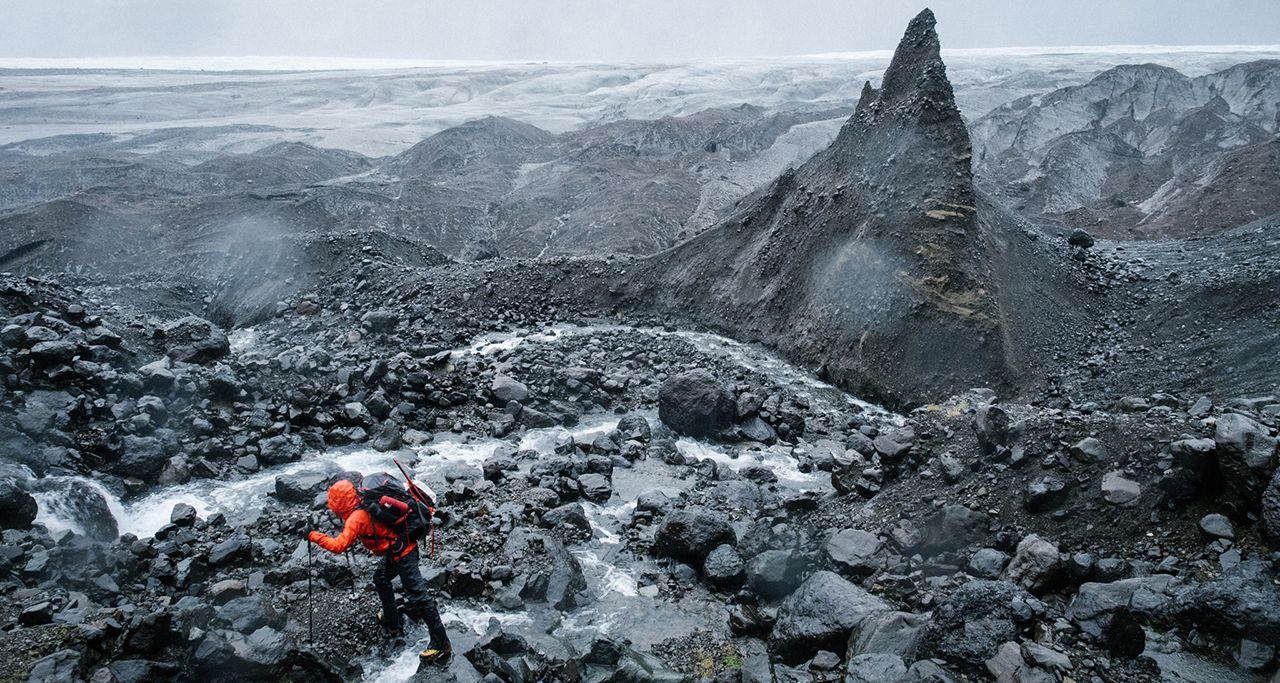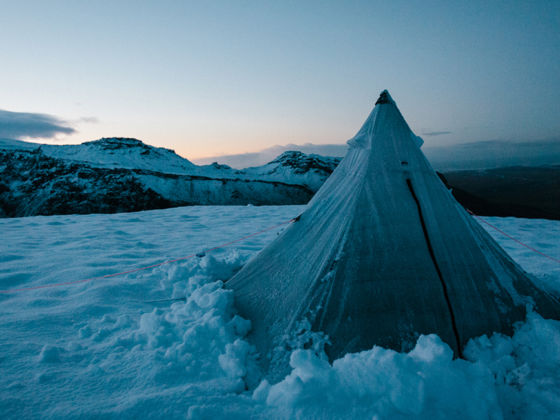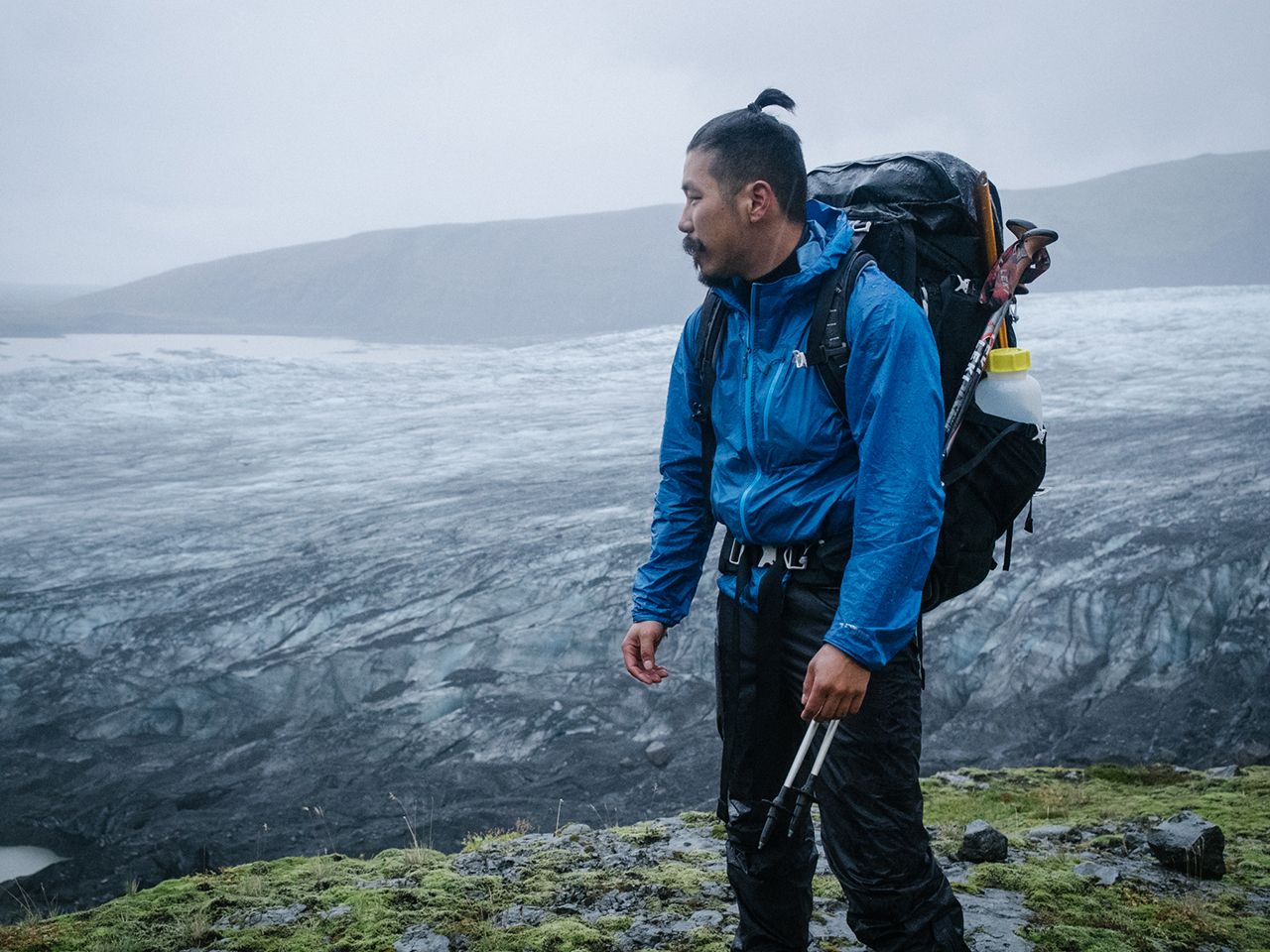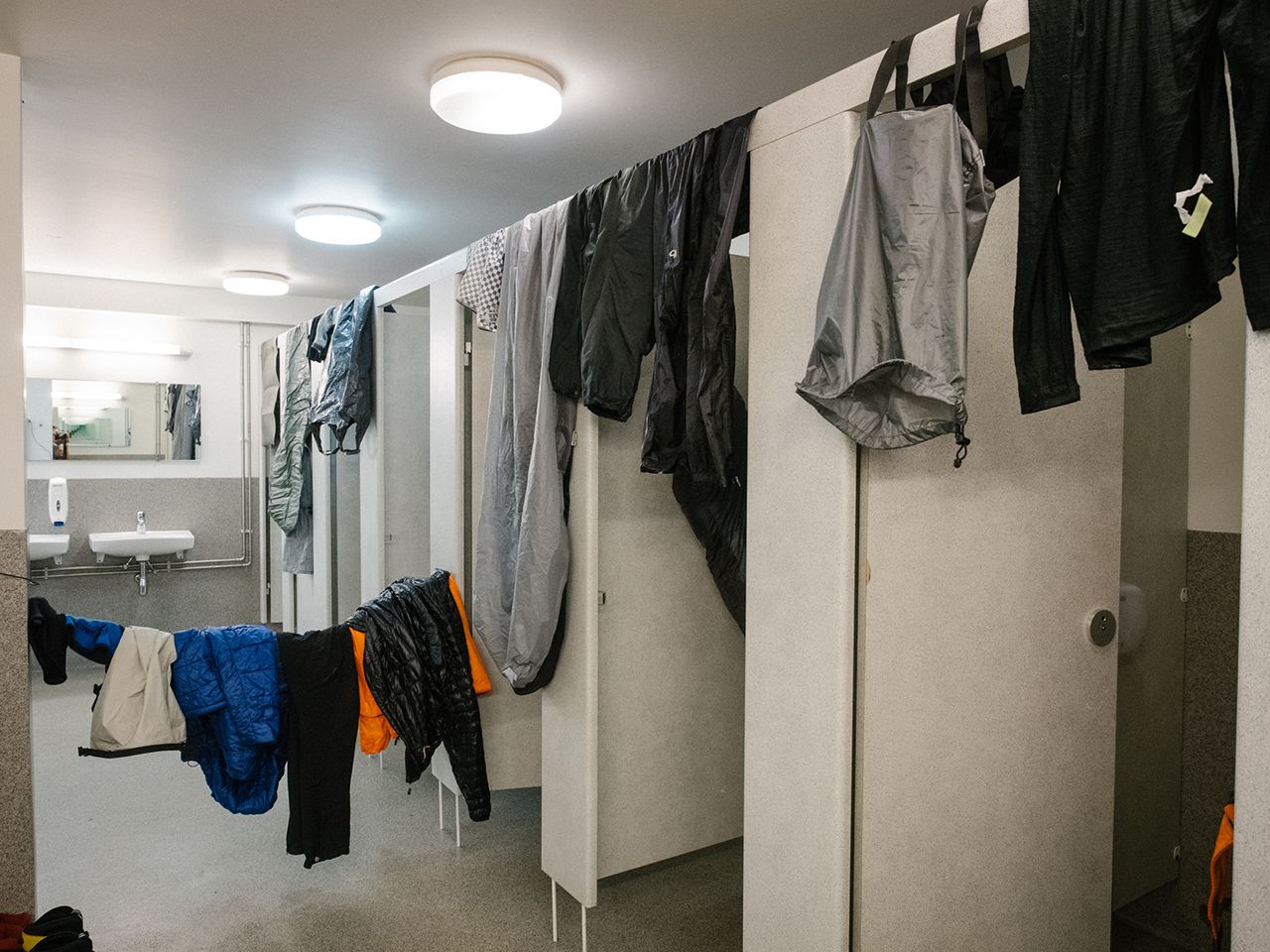
The time Iceland almost killed me
“Winter is coming,” they said.
‘They’ being every local we spoke to in Iceland.
“We’re prepared for winter,” is what Daniel Bruce Lee and I answered every time.
On paper, we were. We had –20° sleeping bags. A bombproof shelter. And the best winter clothing writing for Gizmodo could get us.
Our bodies and minds were prepared too. In March, I did a winter mountaineering course with the American Alpine Institute. We dug 6’ deep snow pits at “base camp” on Mt. Whitney to escape the 60mph gusts of wind that would blow through. It was there that I got my first taste of real winter.
Daniel and I had both come to Iceland (via Norway) from LA. We were ready to experience weather – whatever Iceland had in store.
Our ambitions were simple enough: climb Iceland’s second highest and most scenic peak, Hrútsfjallstindar (1,875m) – and if we were up for it, make a traverse to climb Iceland’s highest peak, the active Hvannadalshnúkur volcano (2,110m).
What we didn’t realize is that Iceland was going to deliver much more than we had bargained for.
Geologically speaking, Iceland is the youngest country in the world – a land of fire and ice. The landscape is constantly evolving and growing.
Currently, the Bardarbunga volcano is erupting. We could feel the ground shake and hear its activity echo throughout Skaftafell, where this adventure takes place. I have never witnessed more beautiful landscapes, yet it’s no wonder why every sci-fi movie that features an inhospitable planet is filmed here.
The flight to Reykjavik from NYC isn’t any longer than the flight from NYC to LA; in five hours you can be transported to another world. Not to mention, visiting Iceland presents some of the world’s best opportunities to experience the Aurora Borealis.
DAY 1
We awoke to the sound of rain pounding on the side of our shelter. We had arrived in Skaftafell, part of Vatnajökull National Park, a few days earlier. When the weather finally broke, we got up to start our day. First things first – check the weather forecast for the week. Seems like 50 percent of our conversations revolve around the weather, and for good reason. We live by it. It would be raining all day. But the next day would be beautiful, and we’d be presented with the perfect conditions for climbing.
After viewing the full report posted inside the visitor’s center, I journeyed across the parking lot to the Icelandic Mountain Guides’ hut. One of their guides, Jón, had told me to stop by that morning; he had route-finding info to share about the climb. Once we had picked his brain, we went over weather conditions on the mountain.
It would be raining until midnight; then the following day would be clear. It hadn’t snowed on the mountain since July. Winds weren’t bad either. It should be a straightforward climb.
I inquired about a possible traverse from Hrútsfjallstindar to the higher Hvannadalshnúkur. He said it was definitely possible, and detailed that route as well.
By the time Jón and I finished chatting, it was only noon. I rushed back to the tent and told Daniel to pack. I figured if we knocked out most of the approach hike that day, it would give us a huge head start on our climb the next morning. We wanted to maximize use of the good weather in order to have the best possible chance of a double summit.
Within 30 minutes we had packed our camping gear, our climbing gear, and two days’ worth of food. Off we went.
Jón had informed us that the cross-country approach began by a parking lot for the outlet glacier. We figured the quickest way to get there would be following a trail from the visitor’s center straight out that direction. What we didn’t realize was that after the trail ended, there would be a swiftly-moving glacial river (above) dividing us from our starting point.
Reluctantly, we followed the river all the way to the bridge where we would cross, then continued hiking for another mile along the road. By the time we arrived at the trailhead, it was nearly 16:00.
No time was wasted, and we continued cross-country hiking along the base of the mountains. One hour later, we turned right and began our ascent in what was now the pouring rain.
Within two hours, we had gained 2,000 feet. By that time, it had stopped raining. It started snowing instead. As nightfall set in, we frantically continued upward, searching for a large enough flat spot to camp. We found the only suitable space around and set up our shelter in the dark to escape the falling snow.
Sleep came easy that night.
DAY 2
“The tent is collapsing!”
shouted Daniel from inside his bivy sack. “Knock the snow off!” I groggily responded back. That had been our routine throughout the night.
We rose before the sun and were surprised to see the entire landscape was blanketed in white – it hadn’t been last night. Nearly a foot of new snow had fallen, the first of the season. We broke camp, roped up, and continued our ascent. As we gained elevation, the sun rose to our right.
Light filtered through the clouds and reflected subtly off the powdery white landscape. The only tracks disturbing the snow were our own. The experience was pristine.
When we finally topped out over the ridge, we continued traversing along the edge. We could see both of Skaftafell’s outlet glaciers below; both of our summit destinations up ahead. The objectives were in sight. “If we could see them, we could achieve them,” I told myself. That is until we hit a dead-end. A cliff guarded the mountain’s approach from one side; a slope too steep to downclimb blocked the other.
Instead of going up that earlier ridge, we should’ve gone around, but the fresh snow did not let us know that. We retraced our steps back a bit, then cut to the right. Down below, remnants of the trail were in sight but by the time we reached it, it was already noon. The summit was in view, but our climb would be doomed. We had wandered through the winter wonderland for hours. If we reached the summit it would be late — that night a storm was blowing in. Time to go down.
Instead of retracing our steps back over that first ridge, we saw a valley to the right: a shortcut down. All good adventure tales begin with a shortcut; this one would be no different.
We quickly descended the valley — plunge stepping through the white snow; then into the green below. My mom had been tracing our steps on MapShare and later sent us a message via our InReach Explorer: “You just descended over 300m in less than 10 minutes. Are you rappelling?” Daniel and I took a long break upon entering the warmer terrain and reflected on the day’s events and our time in Iceland thus far. Little did we know the adventure was only just beginning.
THE DESCENT
We continued descending the valley until we came to a steep waterfall. Our path was easy to trace beyond that obstacle. We’d scramble down the stepped platform alongside the waterfall; to the right were a series of steep scree slopes that we’d slide down. Once we made it off the scree, we’d hop onto the glacier, trek across, and be back at the visitor center by sundown. So we had hoped.
I was the first to go down. I hopped from platform to platform like a hobbit. We were in Middle Earth, after all. At last, I had reached the bottom. One final move remained. I braced my arms against the miniature ravine and lowered myself down to the ground below, but I couldn’t quite reach.
A soft, but sloped mossy landing was just 18” lower, so I spotted the ground and put faith in my step. Arms in. Drop. Landing. Twist.
AGONY!
I misjudged my drop. No time to worry about that, though, because I was rolling downhill and the waterfall dropped off below.
A grassy knoll stopped my roll and I looked up at the waterfall to see Daniel watching in horror. My head was spinning. My vision was blurry. My ears were ringing. What had I done?
I laid there in severe pain doing my best to get a grip on the situation. I gave Daniel an OK signal to show that I was conscious; he climbed down another path to my side. Once I had recovered from the shock, I rolled over, took off my climbing boots and soaked my foot in the ice-cold glacial runoff. I could only bear 10 seconds at a time – the water chilled to the bone.
When I couldn’t take any more, I dried off, socked-on, and booted up. There was no place to camp where I had landed; the nearest site was a couple of hundred meters below, beyond the scree slopes.
We had to move on.
I extended the length of my poles to move downhill – I’d be relying on them a lot from here on out. Each of my steps became a laboriously-calculated move. I knew my bad ankle could not support the weight of another misstep; the slope down was steep. I inched along. The scree was my saving grace, and my gait quickly adapted to the terrain.
I plunge-stepped down, keeping my left leg stiff with each step. There were several small ledges along the way; descending these proved to be most challenging. Iceland’s rock is brittle. Break off a bad piec,e and a miniature landslide would ensue below. For that reason, I led; Daniel kept his distance.
I moved down a larger ledge, one about 4’ in height, and grasped the brittle rock as Daniel navigated the scree in preparation to climb down himself. The loose rock gave below his feet, and he started sliding down.
If he went over the ledge, there would be no regaining control, so I sprung into action. I leaped forward and grabbed his pack, arresting his fall just in the nick of time.
By this point, we were both shaken up, but our objective was in sight. We continued the descent until we reached the only flat patch of ground in view. It was an island of moss, surrounded by some of the most uninviting terrain we’d ever seen.
It would be our safe haven for the night.
DAY 3
I woke up to the sound of rain pounding on the sides of our shelter. I’d come to expect nothing less from Iceland. I went back to sleep in an effort to wait out the rain, but woke up yet again – this time to the sound of our shelter flapping violently in the wind.
Our stakes had pulled up out of the soft moss and were being flung through the air like projectiles. Daniel donned his rain gear and ventured out into the weather in an effort to restore our shelter. His solution of placing massive rocks on top of the tent stakes worked. and we were once again protected from the elements.
The rain and wind never let up.
We were low on food and had no idea how long the severe weather would persist, so I made a resolution: if my swollen foot would fit inside my boot, we’d get the hell out of there. It fit.
By 13:00, we were descending into a bleak and barren area that could best be described as Mordor.
Upon reaching the glacier, we were greeted with even more violent winds. Rain pelted us from three directions at once. The waterfalls around us defied gravity. A cliff to our left intersected with the glacier, blocking our way. The only place to go was forward, so we strapped on our crampons and donned our axes in preparation for war.
Conditions in the valley were violent, but travel on the glacier was hellish. Never in my life have I battled such severe weather in such an inhospitable environment.
The struggle was compounded by my weak ankle. Each step was calculated and labored, for I could not kick in with my left foot. I could barely get a few points on my crampon to stick. Any climbing was done by kicking steps with my right foot while resting on my pole and axe.
I was living life on the edge – the edge of a crevasse.
Our movement was limited by the wind. Rush forward a few steps in between gusts, then brace on all-fours for dear life until it passed. Any verbal communication was drowned out by the forces of nature, but travel became rhythmic, and Daniel and I moved in-sync. I felt like we were living out a video game. The scenario seemed all-too-familiar.
Hours passed by, but we had barely covered any ground. Nightfall was quickly approaching and there was no way we could be out there after dark. I pulled Daniel in close and shouted at the top of my lungs,
“WE HAVE TO GET OFF THIS GLACIER!”
We shifted course and charged forward with newfound resolve, still fighting the wind every step of the way.
Finally, we reached the glacier’s outlet, but we weren’t out of the woods yet. With a bit of hope and even more determination, Daniel and I traveled along the edge of the lagoon, plunge-stepping into the steep slopes of scree for another 800 meters until finally we reached solid, flat ground.
We had made it down alive.
By that time, it was dark, so we ignited our torches and blazed across the barren landscape back to the road. We came to several small streams along the way and stomped through without remorse. Eight hours of torrential downpour had penetrated every square inch of our waterproof clothing and shoes; we were already soaked to the bone.
Once on the road, we mindlessly trudged along – our eyes focused on the glow over the horizon. We thought only of the shelter waiting for us at the visitor’s center six kilometers away.
We finally arrived back at 21:30. A single car occupied the parking lot. No one was around. Daniel and I made a bee-line for the bathroom and began stripping off our water-logged clothing and gear.
We didn’t leave the bathroom that night. We cooked there, and yes, we slept there – our transition to dirtbag life was complete.
Everything could’ve been different if we didn’t take that shortcut. Or if I didn’t misstep. Or if the weather had behaved. Daniel and I signed up for adventure, and that’s what we got. We made conscious decisions along the way and dealt with the consequences. When you go into the backcountry, you have to be prepared for the worst.
I had never felt so out of control of a situation, nor had I ever fought so hard to survive as I did on that glacier. Ultimately we made it out alive, and now we’re better because of it. This adventure was certainly a reminder that mother nature is in control — something we had experienced very little of in the comparatively mild California wilderness. My ankle is feeling better now though, and we’re ready for more.
Finally, this adventure was a testament to teamwork. When Daniel was falling, I had his back. When I fell, Daniel took my heavy gear and carried it in his pack. He also documented every step of my struggle. We would’ve never made it through without teamwork.
This article originally appeared on IndefinitelyWild and is republished here with permission.




